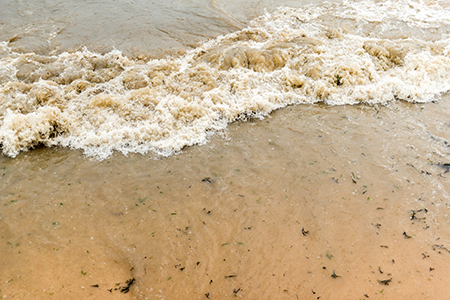Enjoy Summer - Stay Out Of the ED
Summer means tens of thousands of people are visiting Delaware beaches. They are strolling on the boardwalk and spreading out in the sand with towels, chairs, and umbrellas. The Delaware beaches offer a summer playground with the ocean waters bringing relief from the sun’s sweltering rays. Yet, the power of the waves and tides also poses serious health and safety risks.
Each summer season, hundreds of beachgoers end up in Beebe’s Emergency Department because of injuries they sustained while in the ocean. Those injuries can be as benign as a sprained toe, or as serious as a broken neck.
Beginning in the summer of 2010, Beebe Healthcare partnered with Delaware SeaGrant, University of Delaware Center for Applied Coastal Research, Delaware Department of Natural Resources and Environmental Control (DNREC), and several local municipalities to study injuries occurring in the surf zone (the area from where waves form to dry sand). Since the study began, there have been 1,795 patients treated at Beebe for injuries sustained in the surf zone.
For years, beachgoers have been warned of the risk of injury they face when going into the water. Surprisingly, the people who sustain the most injuries are those who are standing in about ankle-deep water. A common scenario is when people are standing and watching the waves or other people around them. They may even be chatting with a friend. Then, they turn around to walk out of the water. While facing toward the beach, they are hit from behind by a wave, which knocks them off their feet and onto the hard sand. Often the person will be tossed and hit by the next wave and sustain more injuries.
Never turn your back on the waves. Injuries happen quickly and unexpectedly. Other common ways that people sustain injuries in the water include when they body surf, boogie board and dive straight into the shallow water where the waves are breaking. In these cases, injuries to the muscles in the neck are common, as are ankle sprains, broken wrists, knee and shoulder injuries.
The problem is that the seemingly calm waters of the beach can be misleading. People look at the ocean and may think it is safe, even though waves are strong enough to cause injuries. According to the results of an ongoing study of surf data and surf injury data, serious injuries have occurred in clusters on what must have seemed to be nice days as injuries rarely occurred on stormy days..
Beebe Healthcare shares some safety tips for those who would like to stay safe while enjoying the local waters.
- Swim near a lifeguard and pay attention to safety instructions. Lifeguards are the local expert regarding swimming hazards. Swim between flags.
- When standing in shallow water, avoid turning your back on the waves as you walk back to your towel. A wave can hit you unexpectedly and knock you down, causing you to dislocate a joint or break a bone. In fact, a small wave can carry as much force as a pick-up truck.
- Be aware of the depth of the water before swimming or diving. Diving into shallow water under the breaking waves can cause a broken neck.
- When you are in the surf, be aware of who is in the water around you.
- Never swim alone.
- Learn the signs of a riptide and avoid the area. If you are caught in one, relax and float. Remember to breathe. Lift your arm up to signal to the lifeguard. If you believe you are a strong swimmer, do not swim against the riptide but swim parallel with the beach until you are out of it.
Please enjoy the summer at the beach and take precautions when you go into the water.




